When you look out on Gull Island–forever preserved by the Leelanau Conservancy in 1996–it’s hard to imagine that someone once lived there. This summer we heard from a woman who did just that. Dorothy Mays Ives, 95, today lives in Amherst MA, and has recorded her memories of a summer spent on the island when she was just 19. The year was 1937 when Dorothy was hired by Professor Ustick of Harvard to provide cooking and household help at his family home on Gull Island. Recently her daughter, Carolyn Dingman, helped her mother to record her memories and developed photo negatives that show the island, the house, and the family.
“At 95, my mother still lives independently in her own home despite being legally blind,” writes Carolyn. “We feel this resilience was developed early on. In the two years before her summer job at Gull Island, her life was turned upside down by the loss of both her parents during the Depression. In spite of severe hardship, she went on to finish at Simmons College, School of Library Science, and worked as a librarian in Amherst before she became a mother of four.”
Dorothy’s Memories
It was 1937, the end of my junior year at Simmons College in Boston. The Ustick family contacted the Dean of the college looking for a cook to travel with them from their home in Cambridge to Gull Island, Michigan, where they had a summer place. I needed a job for the summer and was glad to be hired.
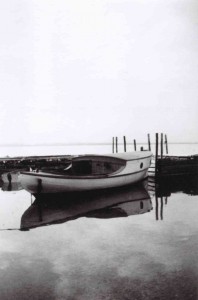
We drove out from Cambridge, I’m pretty sure in two cars with one pulling a rowboat on a trailer. The ensemble included Prof. Ustick, his wife, two daughters, myself, and a Harvard student who would be doing outside chores. I remember the trip took us out from Boston to Western Massachusetts, where I had never been, and on through Ohio on the way to Traverse City and Northport. It was a long trip, several days, and as there were no motels we stayed in cabins along the road or in houses that rented out rooms.
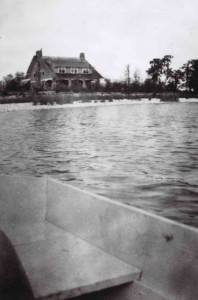
Once in Northport we rowed out to the mooring of the family boat, brought it back to the dock, loaded up, and then made several trips back and forth to Gull Island, transporting our belongings and supplies. It was a trip of perhaps one and a half to two miles each way. One of the photos shows the boat we used, and another shows the island’s dock. The island was flat and there were clusters of trees.
I had been hired to cook and I found the kitchen at the back of the house. There was no electricity or running water; cooking was on a kerosene stove and there were kerosene lanterns to light the house. I believe there was a cistern for water in the kitchen which was filled by the Harvard student. And of course there was an outhouse.
In the main house there were two large fireplaces, one at either end of the building. An enormous, wide wooden table filled one half of the main room; it could sit perhaps 8 people on each side. The other half of the main area was a sitting room, and a flight of stairs led to the 2nd floor.
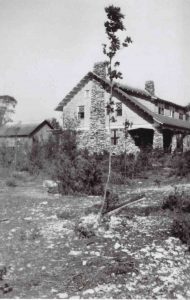
As I recall, I slept in a space over the kitchen in back of the house. I was very aware that I was not a guest or member of the family, I was there to work. This may be because I grew up as the daughter of servants, and I had worked as hired help the previous summer. I would take the meals I had prepared from the separate kitchen into the main house to be served on the large, long table. There was never a tablecloth, it was just bare wood. I did not sit at the table and eat with the family but served the food and returned to the kitchen area.
A vivid memory of my time on the island is making cherry pies. I had learned to make pie crusts a year earlier, and the Ustick family and their guests would bring unsealed cans of processed cherries from a mainland cannery for me to make into pies for dessert. The kerosene stove had two burners, and there was a portable oven that could be placed over the top for baking. I tried very hard to make sure the juice from the pies did not run over onto the stove during baking. I didn’t mind making the pies or preparing muffins for breakfast, but I did not like to cook the large lake trout that the family brought to me from fishing expeditions, perhaps because I had no experience.
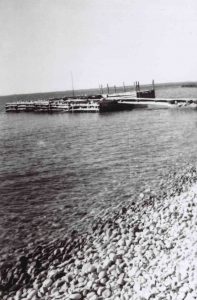
The shoreline of the island was covered with rocks and there wasn’t a beach area for swimming. A plank of wood led across the rocks from the house to the dock, and people would have to use the dock to dive into the water if they wanted to swim. I had not learned to swim, and on my days off I would walk to another part of the island to sit and read or write letters. There were two daughters, one perhaps 15 and the other around 6 or 7. The older daughter would be taken to the mainland by boat so she could attend dances at the yacht club. Shopping also was done on the mainland.
I seem to recall there were frequent visitors, some from Harvard, who would go out with the professor for fishing on the lake. Since there was no beach on Gull Island, we would sometimes boat over to the mainland with a picnic and drive across the peninsula. There we came to a sandy shore that went on for miles, and I remember tall dunes and something called the “singing sands.”
I have a memory of having to go out to get kerosene for the stove, or some other outdoor chore, and having gulls swoop down on me. They seemed to have built nests everywhere, and you had to be careful where you stepped.
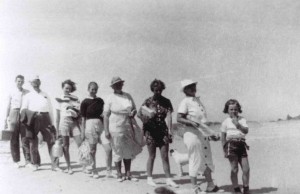
All things considered, it was a very interesting summer and I felt lucky to have a job in the midst of the Depression. Once the summer came to an end, I did not have any further contact with the Ustick family or Gull Island. Only recently have I learned through internet research the names of the family members: William Lee Ustick, Eugenia Blow Miltenberger Ustick, Ellen C. Ustick (later Ellen Williams), and Eugenia E. Ustick (later Eugenia Detzer). None are still living.




